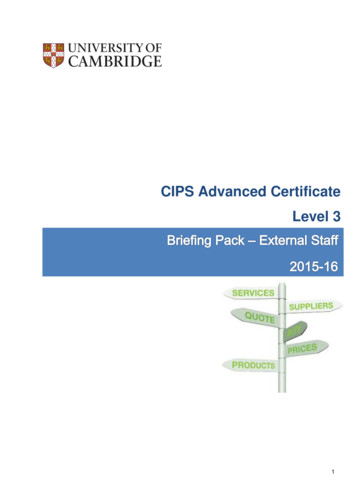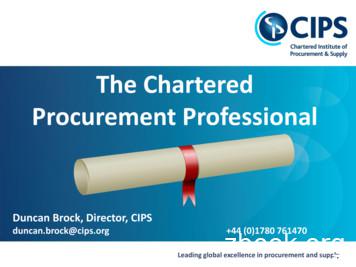CIPS Level 3 Advanced 3 Certifıcate In Procurement And .
CIPS Level 3AdvancedCertifıcate inProcurementand SupplyOperations2018 SyllabusVersion 13
YourqualifıcationThe Chartered Institute of Procurement & Supply (CIPS) qualifications are recognised by educationregulators from various countries. Our Level 3* Advanced Certificate in Procurement andOperations is a vocationally related professional qualification. CIPS is an Ofqual (England), CCEARegulation (Northern Ireland) and Qualifications Wales, regulated qualifications awardingorganisation. The CIPS qualifications are listed on the Regulated Qualifications Framework (RQF).CIPS members will be able to have the confidence in our regulated qualifications, which reliablyindicate the knowledge, skills and understanding that a learner is required to demonstrate.This is an entry level vocationally related qualification itis designed to follow on from the CIPS Level 2 Certificatein Procurement and Supply Operations as learners areexpected to develop, use and apply the professionallanguage and skill sets introduced at Level 2 within apractical working environment. This qualification willprepare intermediate level learners looking to specialisein procurement and supply and to progress onto the CIPSLevel 4 Diploma in Procurement and Supply.Entry levelEntry levelLevel 3AdvancedCertificate inProcurementand SupplyOperationsLevel 2Certificate inProcurementand SupplyOperationsDeveloped in close collaboration with experts from theprocurement and supply profession and businesses, andwith the providers who will be delivering the qualifications,CIPS Level 3 Advanced Certificate in Procurement and SupplyOperations is designed for individuals who will be workingat the Tactical but moving towards the Operational level ofthe CIPS Global Standard for Procurement and Supply. Thisis the first level of the CIPS qualifications structure whereelective modules are introduced, giving learners the choice ofa specific professional path such as Procurement or SupplyHighestEntry levelChain.Level 4Diploma inProcurementandSupplyLevel 5AdvancedDiploma inProcurementand SupplyLevel 6ProfessionalDiploma inProcurementand SupplyNext stepsThis qualification provides progression to the CIPS Level 4 Diploma inProcurement and Supply.* Refers to levels within the RQF. Other regulatory bodies may have different corresponding levelsWe have created a suite of regulated, flexible and agile professionalqualifications that pave the way for a whole new generation of globalprocurement and supply learners.Dr Gary Ramsden, FCIPS Chartered Professional, Head of Education Development and Standards, CIPSBased on the Tactical and Operational competency levels of CIPS Global Standardcips.org/qualificationsLevel 4
30Guide to qualification contentCreditsrequired forcompletionFour CORE MANDATORY modules make up 24 of the required creditsCORE Level 3 Procurementand Supply Environments(L3M1)CORE Level 3 ContractAdministration (L3M3)6CREDITS6CORE Level 3 EthicalProcurement and Supply(L3M2)6CREDITSCORE Level 3 TeamDynamics and Change (L3M4)CREDITS624Credits madeup of COREMANDATORYmodulesCREDITSChoose one ELECTIVE module to make up the final six required creditsELECTIVE Level 3 SociallyResponsible Procurement(L3M5)6CREDITSELECTIVE Level 3 SociallyResponsible Warehousingand Distribution (L3M6)6CREDITS6Credits made upof your choice ofELECTIVEmoduleWho is it for?This qualification will prepare intermediate level learners looking to specialise in procurement and supply andto progress onto the CIPS Level 4 Diploma in Procurement and Supply.What will I learn?Learn how to apply factual, procedural and theoretical knowledge of procurement and supply. You will be ableto completes tasks and address problems that are well-defined but may be complex and non-routine. You willunderstand what relevant information is required and how to interpret and review its effectiveness.Entry requirementsThis is the second entry level qualification, there are no formal entry requirements.Total credits required for completion 3003
Howlong willI study for?Your total qualification time (TQT)The TQT indicates the overall number of guided learning hours, additionalself-study and assessment time that is required.Guided learning hours (GLH)It is expected that you will undertake 200 GLH. The definition of guidedlearning hours is: ‘A measure of the amount of input time required toachieve the qualification. This includes lectures, tutorials and practicals,as well as supervised study in, for example, learning centres andworkshops’.Self-study requirement (SSR)Additionally, we recommend that you also commit to at least [90 SSR]hours. This includes wider reading of the subject areas and revision to giveyourself the best preparation for successfully achieving the qualification.Total exam timeAll the modules in CIPS qualifications are assessed by an examination.cips.org/qualifications300TQT HRS200GLH HRS90SSR HRS10HRS
CCORE MODULECIPS GLOBALSTANDARD2.1 2.2 4.4 11.22HRSEXAM DURATIONHOURS60HRSTOTAL QUALIFICATIONTIME (TQT)6Procurementand SupplyEnvironments[L3M1]Module purposeOn completion of this module, learners will be able to identify the range of environmentsin which procurement and supply is expected to operate and the external factors that canimpact on overall success.Module aim(s)Procurement and supply is to operate in a varied range of environments. As well as thepublic and private sectors, those responsible for the procurement and supply function mayfind themselves working with those in not-for-profit organisations. This module is designedfor those who are involved in the procurement and supply function, who must recognise thewider environment in which they work and the impacts that different types of organisationscan have on successfully meeting with overall organisational needs. They must know theimportance of the external environment and also identify the procedures that regulateprocurement and supply.Credit value05
Learning outcomes, assessment criteria and indicative content1.0 Know the different sectors of procurement and supply1.1 Define the different types and functions of the privatesector Definitions and different types of private sectororganisations – sole traders, partnerships, registeredcompanies, incorporated and unincorporatedcompanies, SME, multinational corporations The size and scope of the private sector in differenteconomies Functions of private sector organisations suchas profit, growth, market share, share price,other financial measures, corporate and socialresponsibility1.2 Describe the role and scope of procurement andsupply in the private sector Sole trade, partnerships, registered companies,incorporated and unincorporated companies Small and medium sized organisations (SMEs) Multinational organisations The roles of procurement and supply in the privatesector1.3 Describe the role and scope of procurement andsupply in the public sector Defining the public sector Central and local government The functions of public sector organisations The roles of procurement and supply in the publicsector Commissioning and procurement Achieving budget savings and other sources of addedvalue Providing access to services Regulating organisations and individualscips.org/qualifications1.4 Describe the role and scope of procurement andsupply in the not-for-profit and third sector Defining the not-for-profit and third sector Public accountability for the not-for-profit and thirdsector Define the role of procurement and supply in thenot-for-profit and third sector2.0 Understand types of pricing arrangements incommercial agreements2.1 Explain how pricing arrangements are used incommercial agreements to ensure effective price andcost management Pricing schedules Fixed pricing arrangements Cost plus and cost reimbursable pricingarrangements Indexation and price adjustment formulae Incentivised gain share pricing Payment terms The use of open book costing and adjustments3.0 Know the external environment and its impact onprocurement and supply3.1 Identify the impact of the external environment onprocurement and supply The use of environmental scanning The use of PEST (political, economic, socialand technological) criteria or STEEPLED (social,technological, economic, environmental, political,legislation, ethical and demographic) criteria thatimpacts on organisations’ external environment The five forces model Competitive market forces Demand and supply Market factors Product life cycles
3.2 Describe how the implications of economic criteriaimpact on procurement and supply Macro-economic criteria such as interest rates,inflation, exchange rates, level of economic activity(GDP/ GNP) that impacts on organisations Micro-economic criteria such as demand and supplythat impacts on organisations3.3 Describe how the implications of political andlegislative criteria that impact on procurement andsupply Political criteria such as stability and instability thatimpacts on organisations, different economic sectorsand on countries Legislation that impacts on organisations such ason standards, health and safety, environmentalstandards and employment law3.4 Describe how the implications of environmental andethical criteria impact on procurement and supply Environmental criteria such as natural risks, wasteemissions, pollution and energy efficiency thatimpact on organisations Ethical and social criteria such as ethical codes,employment rights, community benefits,working conditions and standards that impact onorganisations3.5 Describe how the implications of social criteria impacton procurement and supply Changing societal preferences, tastes and fashions,demographics, labour and fair-trade standards andhow these can impact on organisations Corporate social responsibility4.0 Understand procedures that regulate procurementand supply4.1 Describe the types of documentation used inprocurement and supply Requisitions Orders Delivery notes Invoices Other documents typically used in procurement andsupply4.2 Explain how documented policies and procedures areused within procurement and supply The responsibilities for procurement Regulations relating to competition Levels of delegated authority Responsibilities for the stages of the sourcingprocess Responsibilities for ensuring invoice clearance andpayment Responsibilities for ensuring that requisitions,orders and invoices are clear and correct and clarifyrequirements for stakeholders Corporate governance07
EthicalProcurementand Supply[L3M2]Module purposeOn completion of this module, learners will be able to identify the significance of ethicsfor procurement and supply and define each stage of the sourcing process, explaininghow operational performance can be measured and improved in support of added valueoperations.Module aim(s)The significant impact on reputation and customer perception mean that ethics andresponsible procurement should be at the heart of all organisational procurement andsupply activity. A successful organisation will strive to add value at every stage of itsoperations and will seek ways to measure and improve performance. This module isdesigned for those responsible for the application of ethical codes of conduct on theprocurement and supply operation and who are expected to know how to address potentialconflicts of interest. They must also define tasks associated with each stage of the sourcingprocess and identify the techniques available to achieve added value, recognising howoperational performance can be measured and improved.Credit value cips.org/qualificationsCCORE MODULECIPS GLOBALSTANDARD4.4 7.1 8.2 11.22HRSEXAM DURATIONHOURS60HRSTOTAL QUALIFICATIONTIME (TQT)6
Learning outcomes, assessment criteria and indicative content1.0 Know techniques that can achieve added value and itscontribution to organisational success2.0 Know tasks associated with each stage of the sourcingprocess1.1 Explain how to use techniques to obtain supplies tothe purchaser’s requirements Defining sources of added value Defining value for money Applying the five rights to procurements of bothproducts and services Discuss the concept of life time costs2.1 Describe how procurement needs are established Liaison with users and customers and understandingtheir commercial needs Reviewing needs from customers The make or buy decision Definitions of specifications1.2 Identify the contribution that value for money has tomake to organisational success Efficiency Effectiveness Economies of scale vs. quality of product/service Value engineering Value analysis2.2 Identify criteria that should be applied in creatingspecifications The importance of specifications in contracts withexternal customers and suppliers Creating specifications for products and services Conformance and output or outcome basedapproaches to developing specifications The role of Key Performance Indicators (KPIs)1.3 Explain how to use techniques that are available toachieve quality supplies Defining quality Quality standards, processes and procedures The use of quality assurance The concept of zero defects Assessing quality of supplies of products and services2.3 Describe approaches to the sourcing of supplies Surveying the market Supplier appraisal Inviting quotations and tenders Assessing quotations and tenders The use of e-sourcing technologies Measuring supplier performance1.4 Identify techniques to secure required quantitieswithin required timescales Internal, external and total lead time Expediting and measuring delivery performance2.4 Describe approaches to the formation of agreementswith external organisations Dealing with queries and clarifications Ensuring transparency and fairness with suppliers Mistakes and second bids in tenders The use of reverse auctions/e-auctions Forming agreements with customers and suppliers Transition and mobilisation arrangements1.5 Identify value for money criteria Pricing/costs Delivered quality Timescales, quantities and location requirements Measuring the achievement of quality and timescales Evaluate data to measure and improve theperformance of external suppliers09
3.0 Understand the significance of ethics for procurementand supply3.1 Explain the importance of the CIPS Code of Conduct inprocurement and supply Enhancing and protecting the standing of theprofession Maintaining the highest standard of integrity in allbusiness relationships Promoting the eradication of unethical businessrelationships Enhancing the proficiency and stature of theprofession Ensuring compliance with laws and regulations3.2 Describe the use of codes of ethics in procurementand supply The importance and role of codes of ethics Monitor the work of stakeholders to ensure thatcodes of ethics are upheld How to deal with and escalate to senior managementany suspected breaches of codes of ethics3.3 Explain the conflicts of interest that can exist in thework of procurement and supply and how to deal withthem Identifying potential conflicts of interest How to address potential conflicts of interest How to ensure that ethical practices are maintainedand prioritisedcips.org/qualifications4.0 Understand how operational performance of theprocurement and supply function can be measuredand improved4.1 Recognise the importance of delivering customerservice and how to improve Methods to evaluate customer service andstakeholder satisfaction How to develop action plans to improve performance4.2 Explain ways to measure cycle times for the sourcingprocess Methods to evaluate the timescales for sourcingprocesses How to identify the causes of delays and takeappropriate actions to reduce timescales whenrequired4.3 Explain methods to assess the performance of andcontrol budgets Methods to analyse departmental budgets andevaluate the reasons for variances betweenforecasted and actual expenditures Define methods and actions to mitigate futurevariances
CCORE MODULEContractAdministration[L3M3]CIPS GLOBALSTANDARD6.2 7.3 8.32HRSEXAM DURATIONHOURS60HRSTOTAL QUALIFICATIONTIME (TQT)6Module purposeOn completion of this module, learners will be able to explain administrative processesbehind contract development and how to measure contract performance. They will identifyhow to achieve competitive pricing and be able to describe how effective tendering isachieved.Module aim(s)In any organisation, a significant element of the procurement and supply function isbased around the contracting process. This module is designed for those involved in thedevelopment and subsequent administration and performance monitoring of contracts. Toensure success, such individuals must demonstrate knowledge and comprehension of howto achieve competitive pricing and also how effective tendering is achieved.Credit value11
Learning outcomes, assessment criteria and indicative content1.0 Know the administrative content and key tasksassociated with commercial contracts2.0 Understand how to achieve competitive pricing andthe role of negotiation in procurement and supply1.1 Identify types of contracts and agreements Spot purchases Term contracts Framework agreements (or blanket orders/panelagreements) Call offs2.1 Explain the use and comparison of competition toobtain quotations on price The use of competitive pricing with suppliers throughmonitoring prices and obtaining quotations Comparing historical prices with newly quotedprices and evaluating the reasons for any significantdiscrepancies Taking appropriate actions to secure competitivepricing1.2 Describe the purpose of the documents that composea contract for the purchasing or supply of goods and/or services The specification The key performance indicators (KPIs) The contract terms The pricing schedule Other schedules (such as health and safety, use ofsubcontractors) Non-disclosure/confidentiality agreements1.3 Describe the stages involved in forming contracts forthe purchasing or supply of goods and/or services Requests for quotations/information/tenderenquiries Quotations/tenders received Orders/acceptance of tenders Delivery notes/acknowledgements Invoicing and payment The use of contract registers1.4 Describe how to develop and present business casesto justify expenditure on supplies, services or projects Costs Benefits Options Alignment with organisational needs Timescalescips.org/qualifications2.2 Recognise the role of commercial negotiations in thework of procurement and supply Definitions of commercial negotiation Collaborative win-win integrative approaches tonegotiation Distributive win-lose distributive approaches tonegotiation Negotiation in relation to the stages of the sourcingprocess Sources of conflict that can arise in the work ofprocurement and supply The influence of stakeholders in negotiation2.3 Explain approaches to negotiate competitive prices The link between costs, price, margins and mark-ups Use available data on submitted prices Retain or improve other aspects of value for moneysuch as quality, availability and sustainability withinthe negotiation process Analyse actual outcomes from the negotiationprocess with planned outcomes and evaluate thereasons behind any differences
3.0 Know how effective tendering is achieved4.0 Understand how to measure contract performance3.1 Identify the initial actions processes associated withthe tendering process Supply/market research Early supplier engagement Pre-contract dialogue Develop and improve commercial and technicalsolutions4.1 Describe the use of data as a contract performancemeasure Types of data Data gathering and analysis methods Actions to address under performance Penalty clauses3.2 Describe initial tender process documentation andassociated content Invitations to tender KPIs Contract terms Pricing schedule and other special to type schedules Prequalification questionnaires3.3 Identify the tender evaluation and acceptance process Check tender det
CIPS Level 3 Advanced Certificate in Procurement and Supply Operations is designed for individuals who will be working at the Tactical but moving towards the Operational level of the CIPS Global Standard for Procurement and Supply. This is the first level of
CIPS Asia PacificIG Rochester Drive, Level HJ, Singapore, GINLIM TPLK LNFN NMHG FPLK LNFN NMHH Einfosg@cips.org CIPS AustralasiaLevel H, KHF Collins Street, Melbourne, Victoria IFFF, Australia TGIFF MLK GJH/PLG (F)I OLHO LFFF FGIFF MLK GJI/PLG (F)I OLHF KJNN Einfo@cipsa.com.au CIPS MENAOffice GMFI, The Fairmont Hotel, Sheikh Zayed Road, PO Box GGOMMJ, Dubai, United Arab Emirates TPOMG (F)J IGG .
CIPS Level 5 5 Advanced Diploma in Procurement and Supply Ref: 603/3925/1 6\OODEXV Version 1 Fhyzics Business Consultants Pvt. Ltd. An Approved Study Centre of CIPS, UK www.IISCM.org cs@fhyzics.net 91 900-304-9000. Your TXDOLIÂFDWLRQ Next steps 7KLV TXDOL 4FDWLRQ SURYLGHV SURJUHVVLRQ WR WKH CIPS Level 6 Professional Diploma in Procurement and Supply. 5HIHUV WR OHYHOV ZLWKLQ WKH 8. 54 .
The University CIPS Level 3 Programme 2.1. About the CIPS Programme The University’s CIPS Level 3, Advanced Certificate in Procurement and Supply Operations programme is partly funded through the Finance Division. You may apply if you work in one of the University colleges, the University Press or Cambridge Assessment or other associated institution, although funding will be requested from .
Leading global excellence in procurement and supply 1 The Chartered Procurement Professional Duncan Brock, Director, CIPS duncan.brock@cips.org 44 (0)1780 761470 . Leading global excellence in procurement and supply 2 Introducing CIPS Chartered Body Charitable Status Awarding Body Membership Organisation CIPS for Business . Leading global .
platforms/channels,, you agree to accept any changes made to the terms and conditions. CIPS Membership Subscriptions and MyCIPS CIPS Membership subscriptions and all CIPS membership fees quoted are for annual subscriptions (12- months). You are required to renew and mak
CIPS Position on Practice P&SM: Contract . Management . The activities of a buyer before, durin g and after a contract is signed, to ensure that all parties to the contract understand and fulfil their contractual obligations. CIPS members can record one CPD hour for reading a CIPS Knowledge
It is designed as a follow on from the CIPS Level 2 Certificate in Procurement and Supply Operations as learners are expected to develop, use and apply the professional language and skill sets introduced at Level 2 within a practical working environment. Individuals will be working at the Tactical but moving towards the Operational level of the CIPS Global Standard for Procurement and Supply .
5. Tax and Corporate : Referencer, Bharat Law House (P) Ltd., 22, Tarun Enclave, Pitampura, New Delhi – 110 034. 6. Customs Cases : Fortnightly Reporting Journals; Indirect Tax Laws of India (P) Ltd., Chennai. (ix) ARRANGEMENT OF STUDY LESSONS PAPER 7: ADVANCED TAX LAWS AND PRACTICE (100 Marks) Lesson No. Topic PART A: DIRECT TAX MANAGEMENT (30 Marks) I. Taxation of Individual, Partnership .























